Mental product management models for everyone

Mental models are simple expressions of complex processes or relationships. These models can be assembled and used to make faster and better decisions.
Here's an example: the Pareto principle says that about 80% of all results are in 20% of the effort.
In the context of product management, the model assumes that instead of spending 100% of the effort and covering 100% of the customers desires, you can spend 20% - and satisfy 80% of the desires. Development teams constantly resort to this principle, and the results often look good when 20% of clients with more complex cases are not supported.
Mental models can be powerful tools, but their usefulness is limited by the contexts from which they are extrapolated. To overcome this limitation, do not rely on one or even several models - instead, you must constantly build a network of mental models that you can rely on to make optimal decisions.
This concept was popularized by Charlie Munger, the celebrated vice chairman of Berkshire Hathaway, in a speech where he reflected on how to gain wisdom:
What is elemental, worldly wisdom? Well, the first rule is that you cannot know anything if you just remember individual facts and try to apply them. If the facts are not related, you do not have them in a usable form.
Models should be in your head. You must integrate all the experience — yours or that of which you only know — into a network of models. You have probably seen students trying to just remember facts and just as randomly recall them. They fail in learning and living. You have to build a network of models to use the experience.
What models? Well, the first rule: you must have several models - because if you know and use only one or two models of the development of events, you will have to constantly adapt to their reality painfully. You become the equivalent of chiropractor, which, of course, is a big boob in medicine.
This is like an old saying: "For a person who has only a hammer, every problem looks like a nail." And, of course, that’s how a chiropractor practices medical practice. But this is a completely catastrophic way of thinking and a completely catastrophic way of acting in the world. Thus, you should have several models.
This post describes some of the most useful mental models I've accumulated over my career in product management. As I study new models, I will constantly update the post.
This post is not just for product managers, it is for everyone who works on products. Product thinking is not sacred to the role of PM; in fact, it is even more useful in the hands of builders than PM.
The mental models that we will consider are divided into categories:
- Search for a project for investment
- Design and Review
- Delivery and development
Finding a project for investment - the following set of mental models is useful for deciding what your team should do or where to invest.
1. Return on investment
Financial concept: how much do you get for every dollar invested? In the product, think of the resources that you have (time, money, people) as what you “invest”, and of profit — as an impact on customers.
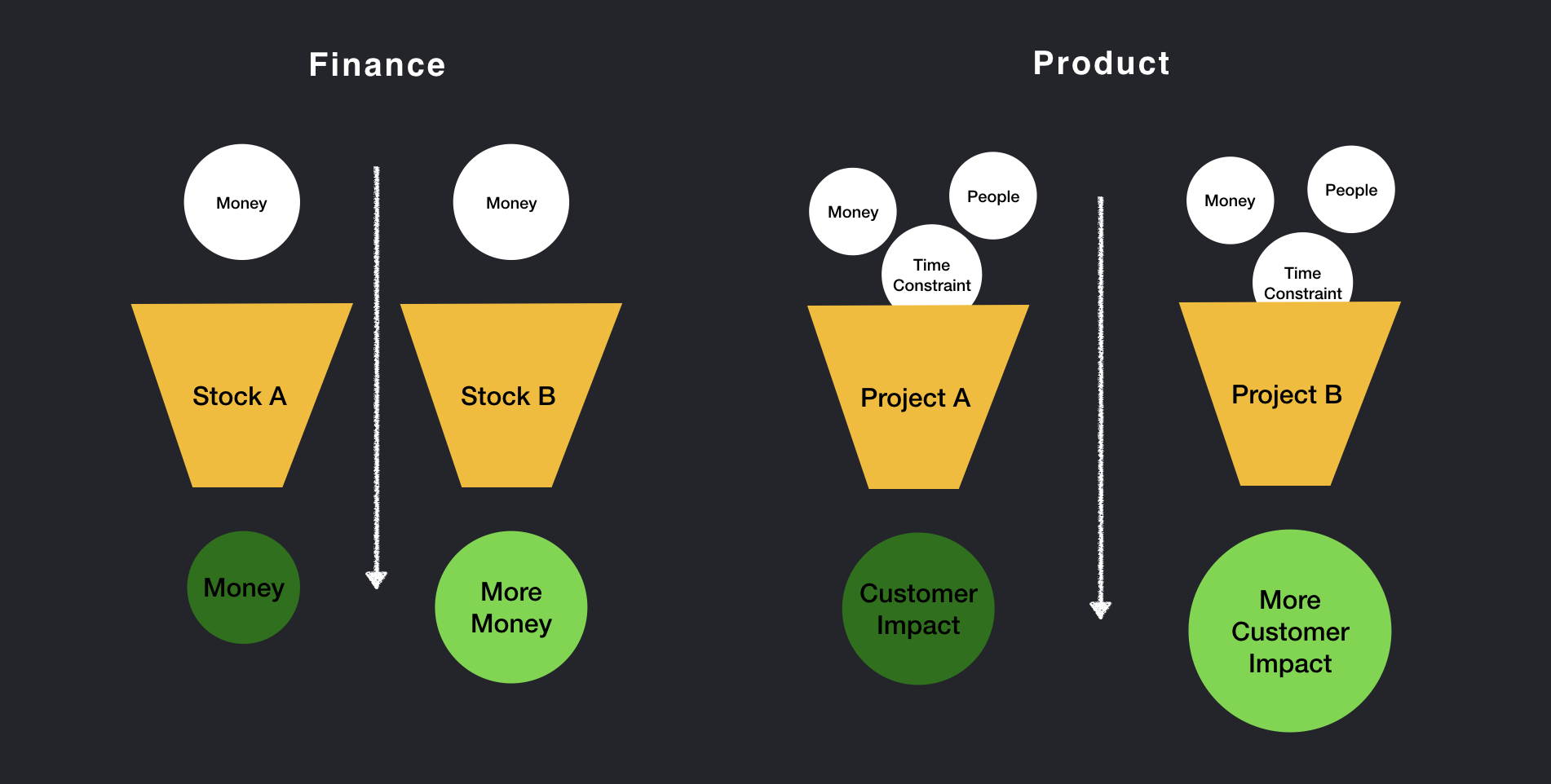
Why is it useful
The resources available to the development team are time, money, people and their skills. When you compare projects that you can take on, you should always choose the one that maximizes the impact on customers for each unit of resources you have .
2. Time shipping cost
Goods delivered earlier cost more to customers than those delivered later.
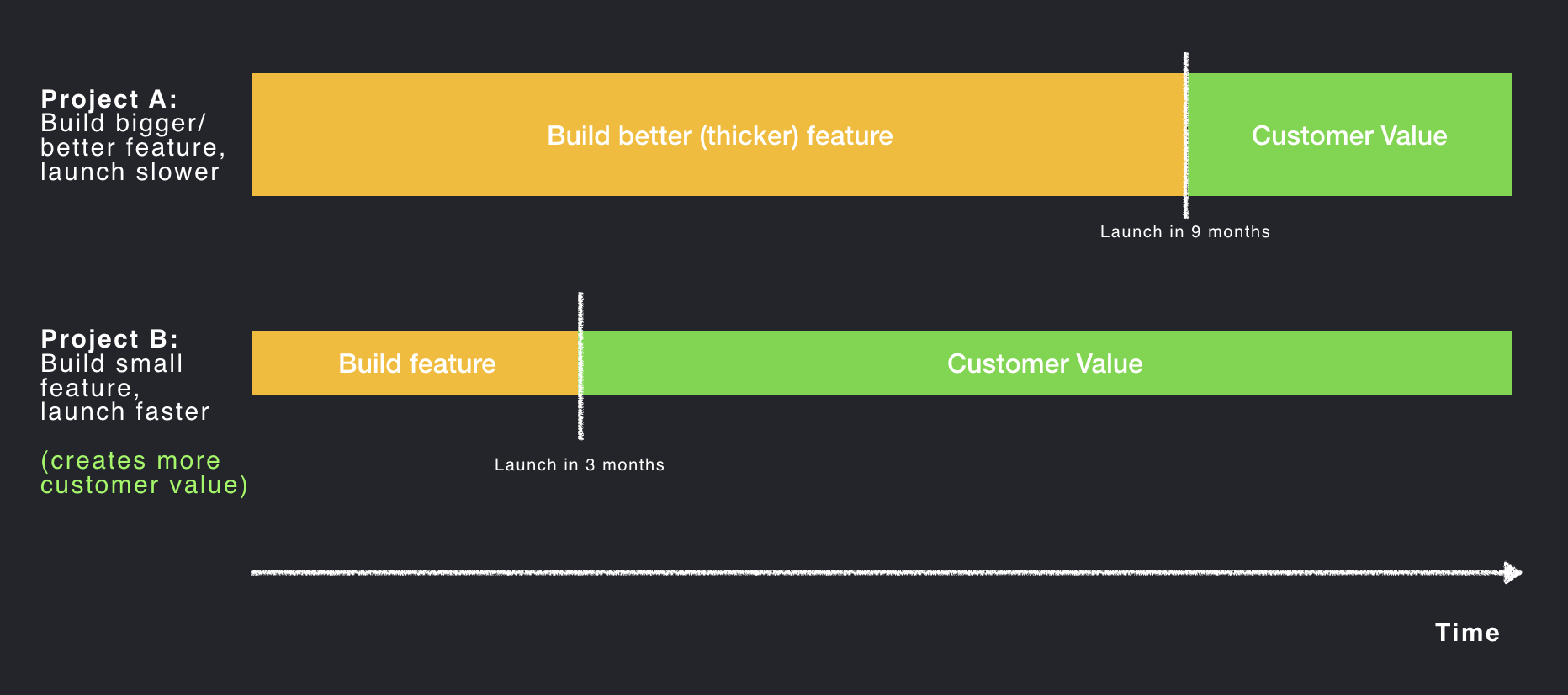
Why is it useful
When deciding on problems / investment opportunities, you cannot just compare the advantages of various features that you can realize (if you did, you would always choose the most significant feature).
Instead, in order to make the right investment decisions, you must also consider how quickly these features will be delivered and give more weight to those that can be rolled out faster.
3. The time horizon
The correct investment decision depends on the period of time that you optimize, and the time and cost of delivering features.

Given a fairly long time interval, the development cost of 3 months versus 9 months is negligible.
Why is it useful
If you ask, “How can we make the most impact in the next 3 months?” Or “How can we make the most impact in the next 3 years?” This will lead to radically different decisions for your team.
It follows that agreeing with your team and stakeholders on which time horizon to optimize is often the first thing you should discuss.
4. Expected value
Predicting the future is very difficult. All decisions create the probabilities of multiple outcomes. The weighted sum of these results is the expected value of the decision.

Why is it useful
When considering the impact of a project, outline all possible outcomes and identify probabilities. Variability of the result usually includes the likelihood that it will take longer than expected, or that it will not solve the client’s problem.
After you state all the results, make a weighted sum of the values of the results, and get a more accurate estimate of the return on investment.
Design and volume determination - the following set of mental models is useful for determining the volume of work and product implementation after you have chosen where to invest.
5. Work in the opposite direction (inversion)
Instead of starting with a problem and then exploring it, start with the perfect solution and go back to the present moment to figure out where to start.

Note that working in the opposite direction is not always better; it just creates a different perspective.
Why is it useful
Most teams strive to move forward in their work , and as a result optimize what ultimately leads to the goal.
Working in the opposite direction helps you focus on the most productive and long-term work for clients, because you always start from the perfect solution for them.
Note that working in the opposite direction is not always better; it just creates a different perspective. It's great to plan using both perspectives.
6. Confidence determines speed vs. quality
Confidence that you:
1) solve an important problem
2) the solution you implement is correct
determines the compromise between speed and quality when creating a product.
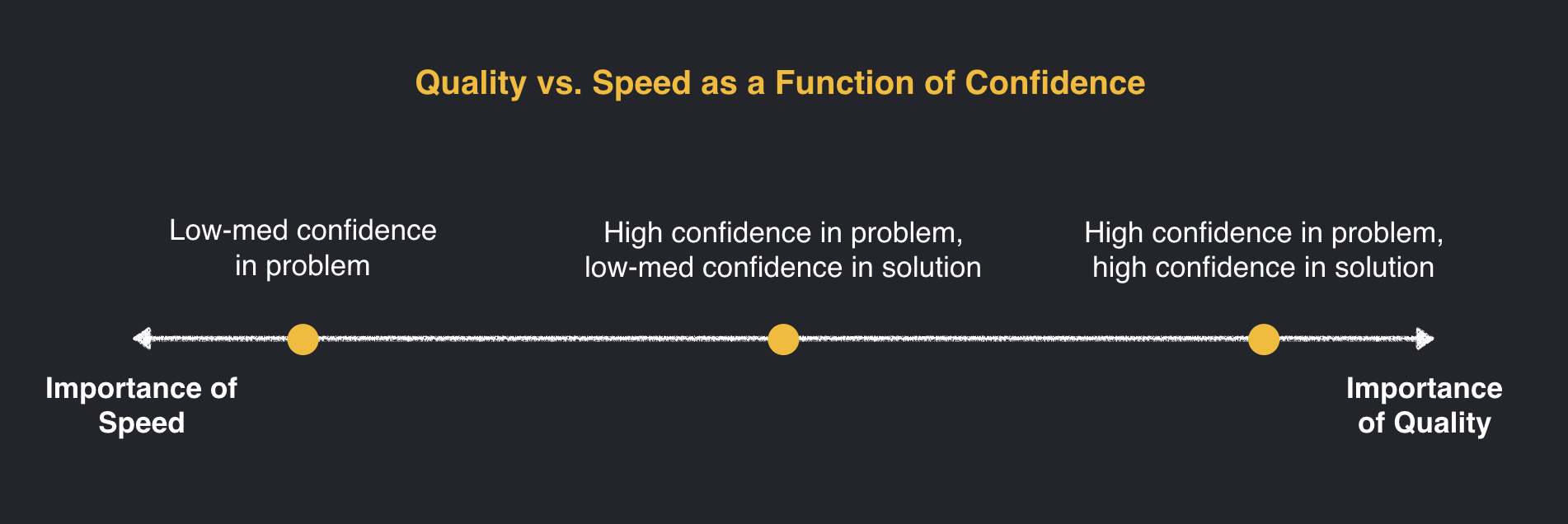
Why is it useful
This smart model helps you build a barometer to intelligently combine speed and quality. The easiest way to explain this is by looking at the extreme points of the graph above.
Right: you have confidence (confirmed by customers) that the problem you are focusing on is really important to customers, and you know exactly how to solve it. In this case, you should not choose quick solutions, because you know that customers will need this feature forever, so it must be really high quality (for example, scalable, amazing).
Left: You have not even confirmed that the problem is important to customers. In this scenario, the longer you invest in development, the greater the risk of creating a solution to a problem that does not even exist. Therefore, you can verify by running something quick and receiving confirmation from the client that it is really worth doing. For example, make a landing page for a feature that doesn’t even exist in order to evaluate the interest of customers.
7. Embrace the entire customer experience.
Customer experience does not end on the interface. What happens before and after using the product is equally important for development.

Why is it useful
When developing a product, we tend to place too much emphasis on experience working with the product (for example, the quality of the interface on the site or in the application).
It is equally important to think over the marketing experience (how you attract customers and set their expectations for the product before they use it), and the support / distress experience (how your company copes if something goes wrong.).
Creating a positive experience in a difficult situation is an amazing opportunity to gain long-term customer confidence. For example, Amazon gains maximum credibility when it helps customers return something.
Case of life
(Nastya Utkina - Ozon Premium, Apparel & Beauty Product BX)
A month after the launch of the Ozon Premium recurrent subscription (when the main technical launch fires were extinguished and we were able to exhale a little), we launched a series of telephone surveys of different subscription user groups:
1) those who bought a subscription without automatic renewal
2) those who bought a subscription with auto-renewal and recurrent payments
3) and those who were presented with it (the smallest group of our core users with very high ARPUs)
Our task was to explore how each group understands the value of a subscription and what barriers they are currently experiencing when buying a recurring subscription.
We were surprised to find that many users to whom we gave the subscription did not notice the appearance of Premium even if there were different messages about this in the product.
Users who bought a subscription could clearly articulate its value for themselves.
On the other hand, it turned out that one of the barriers to buying / renewing a recurring subscription is doubts that the subscription will be economically beneficial to the user.
We began to think how we can visualize the benefits of the product for all types of subscribers.
The first step was a vivid visualization of premium prices for goods: a special badge that shows the holder of the subscription how much this product would cost without it and to the user who does not yet have a subscription - how much the goods cost with it.
The next step, we learned to consider for each user savings on premium prices and delivery for each order made by him. Very soon, in the subscription management section in your account, you will be able to choose the month of using the subscription and see the amount that the client has saved.
8. Experiment, feature, platform
There are three types of product development: experiments, features, and platforms. Each has its own goal and the ratio of speed and quality.

Why is it useful
Understanding your type of product development, you will choose the optimal goals for each type, and adjust the speed and quality of development.
The experiments are designed to test hypotheses, so you can invest in new features or platforms if the client liked the experiment. If you are testing a hypothesis, you can allow things that would otherwise be unacceptable: for example, use a “shit code” that would need to be thrown away or fake application logic.
Unlike experiments, platforms are eternal. Other people will create features on top of them, and therefore making changes to the platform after its launch is highly undesirable.
Therefore, platform projects must be of very high quality (stability, performance, scalability, etc.), and they should actually include the creation of useful features. A good rule of thumb when creating a platform is to create it together with your first consumer, that is, have a second team that simultaneously creates features on your platform while you are developing it - this way you guarantee that the platform really uses useful functions.
9. Feedback
Cause and effect in products are the result of cycles of positive and negative feedback.
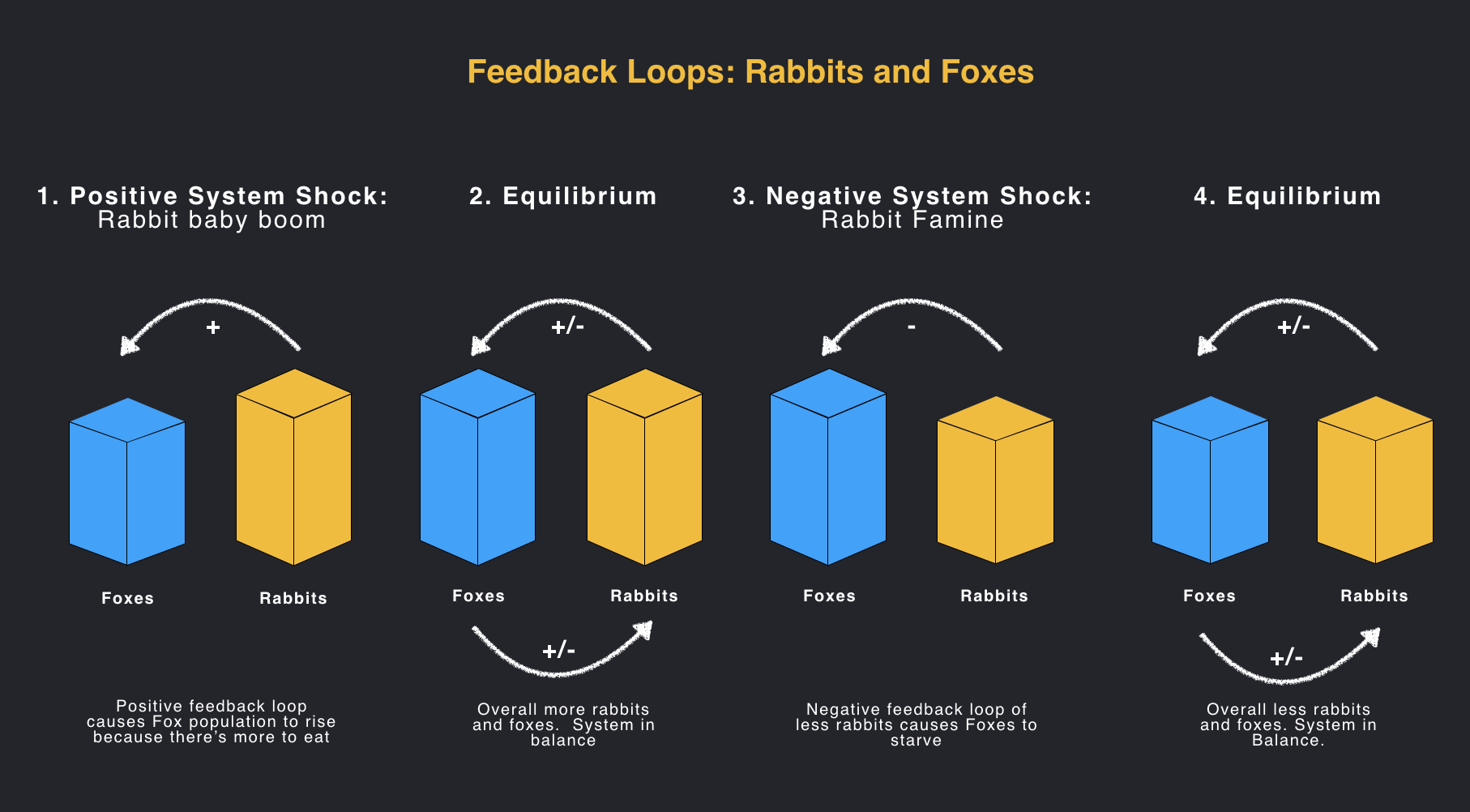
Why is it useful
Feedback loops help us remember that some of the main factors that increase or decrease a product may come from other parts of the system.
For example, suppose you are a payment specialist, and your KPI depends on the total number of credit card payments processed. You have positive feedback with the user engagement team, because as the user base grows, so does the number of transactions. At the same time, you have negative feedback from the cash payment group, which is trying to help users make cash transactions easier.
Knowing these feedback loops can help you change your strategy (for example, you can choose a general way of attracting users as the best way to increase the volume of payments) or understand negative changes in your indicators (for example, the volume of payments on credit cards has decreased, but this is because the team cash payments does its job really well, and not because loan products suck).
10. Flywheel (recursive feedback loop)
A state where the loop of positive or negative feedback feeds on its own and accelerates from its own impulse.
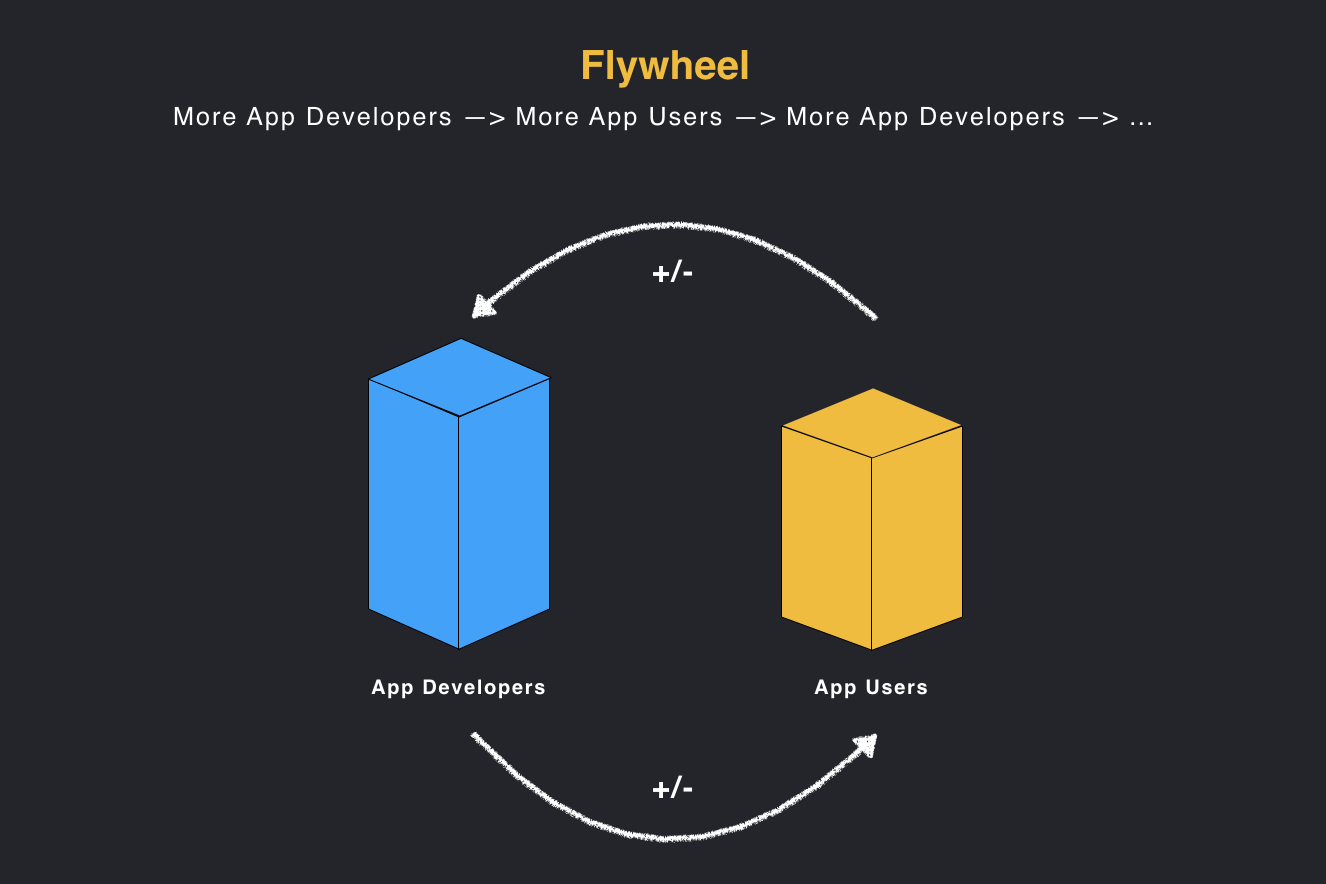
Why is it useful
Flywheels are a concept related to feedback loops, but they are important for managing platforms and markets. Imagine that you are using the Apple app platform for iOS. You have two user groups: application developers and application users.
A flywheel is a phenomenon when the more users have applications, the more developers write these applications. (because there are more sales opportunities), which in turn attracts more application users (because more applications are bought), which in turn attracts more application developers, and so on. While you are swinging the flywheel, the product will not only grow, but grow with ever increasing speed.
If you operate a flywheel, you must do everything possible to make it rotate in a positive direction, because it is also strong in the opposite direction. For example, if there are so many applications on the platform that new services cannot be developed, the number of developers will stop growing - you need to solve this problem.
Build and Repeat - The next set of smart models is useful when you create, operate, and repeat an existing product.
11. Lower profits
If you focus on improving one area of the product, the value of customer value created over time will decrease per unit of effort.

Why is it useful
Assuming that you are effectively improving the product based on customer feedback and research, you will eventually reach a point where you can do nothing more in this direction. It's time for your team to move on and invest in something new.
12. Local maxima
Due to the decrease in profitability, local maximums are points at which gradual improvements do not create any value for the client at all, forcing you to take a step in changing the capabilities of the product.

Why is it useful
This mental model is closely related to diminishing returns. Iterative development now makes no sense, and the only way to progress is through innovation.
This concept was recently popularized by Eugene Way's viral publication Invisible Asymptotes , which describes how this model helped Amazon create its Prime subscription.
13. The second version is a lie
When creating a product, do not count on the second version. Make sure the first version is a finished product, because it can last forever.
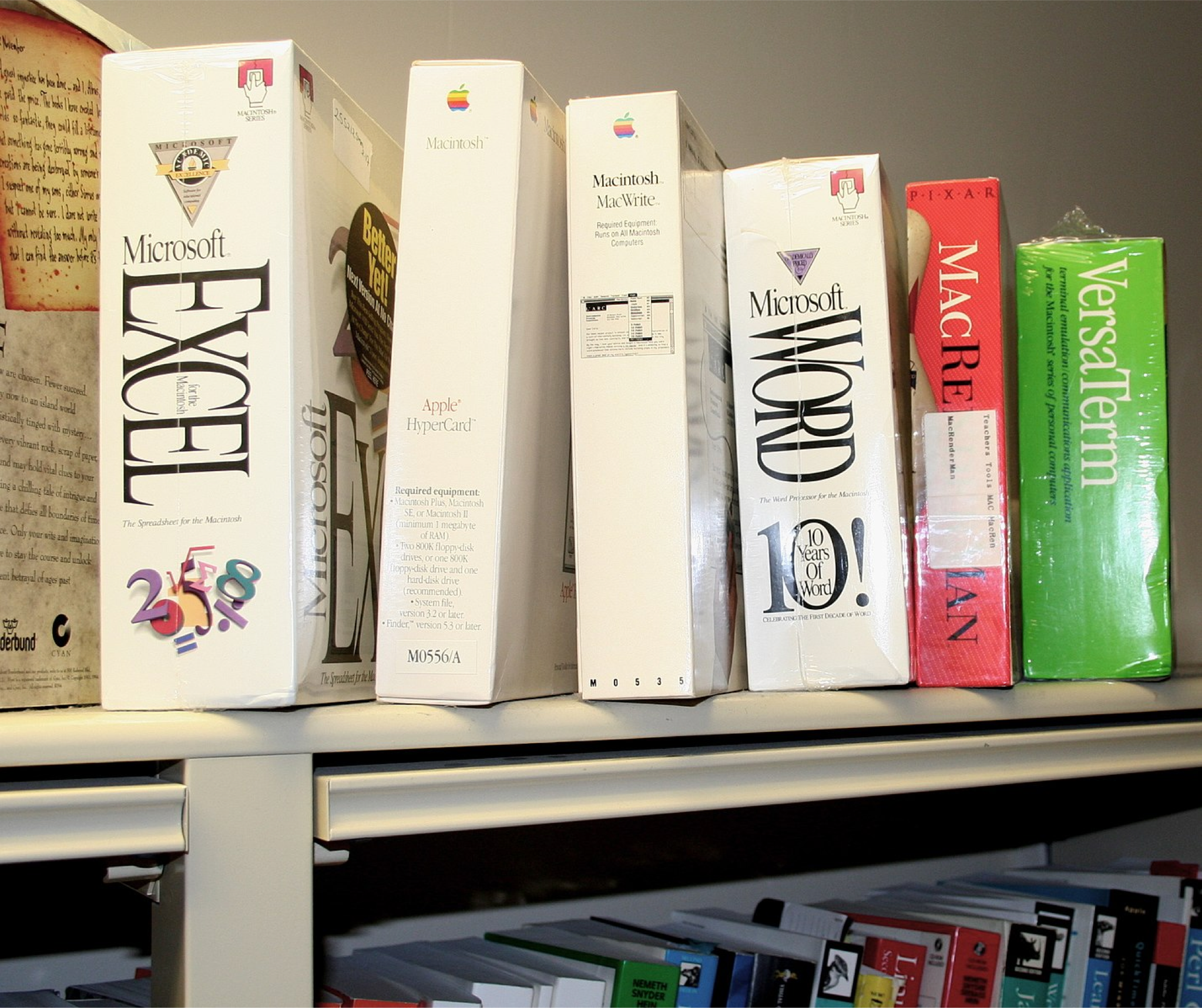
When software was sold on shelves, teams had to live with version 1 always.
Why is it useful
When you determine the first version of your product, you accumulate all sorts of features that you dream of adding later in future versions. Recognize that they may never go into production because you don’t know what might happen: changes in the company's strategy, your lead engineer leaves, or the whole team is redistributed to other projects.
To insure against these scenarios, make sure that what you are doing is a product that without improvements will be useful to customers in the foreseeable future. Do not ship a feature that depends on future releases to really solve the problem.
14. Freeroll
A situation where you can lose a little and win a lot by delivering something quickly.

Why is it useful
Freerolls usually appear in a product when the current user experience is so poor that making any reasonable changes based on intuition can make it much better.
If you are in a situation where your team thinks: “Let's just do something ... we can't do it worse” , you will most likely have a freeroll.
( r / CrappyDesign on Reddit - a storehouse of such situations)
15. Most of the cost is created after the first version
After you launch the product, you will learn more about the client, do not miss the opportunity to use this knowledge.
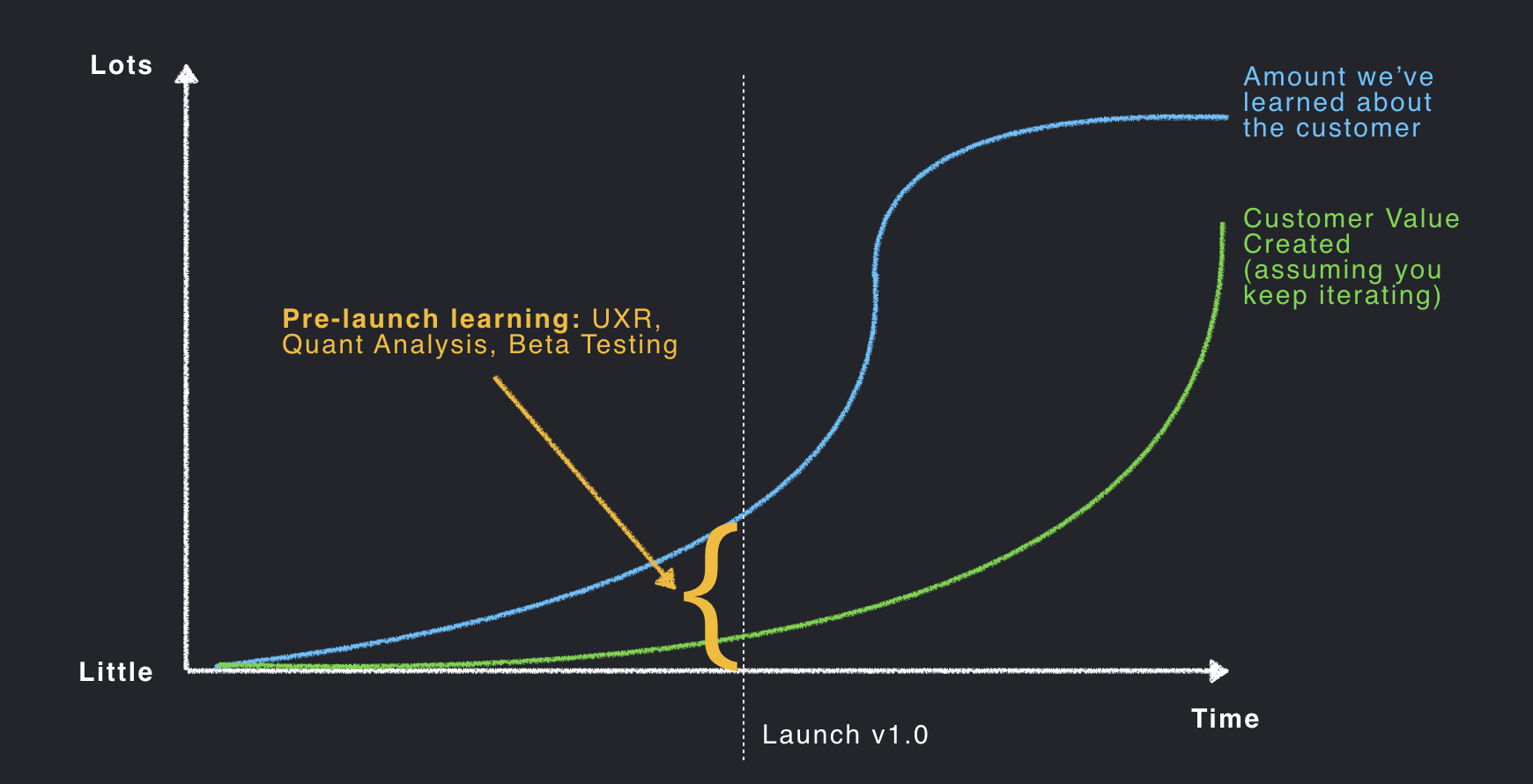
Why is it useful
Everything is a hypothesis until customers use the product. The time the team spends in “pre-launch testing” - interviews with customers, prototype testing, quantitative analysis, beta testing, etc. - can give you a great chance that you are doing everything right. But there will always be cases that appear only when you roll out the feature to all customers.
The greater the percentage of customers who have tried your product, the more you know about it. With this in mind, it makes no sense not to invest in iteration.
16. Key Failure Indicator (KFI)
Comparing Key Performance Indicators (KPIs) with indicators that you don’t want to reduce goes in a certain direction so that you focus on healthy growth.
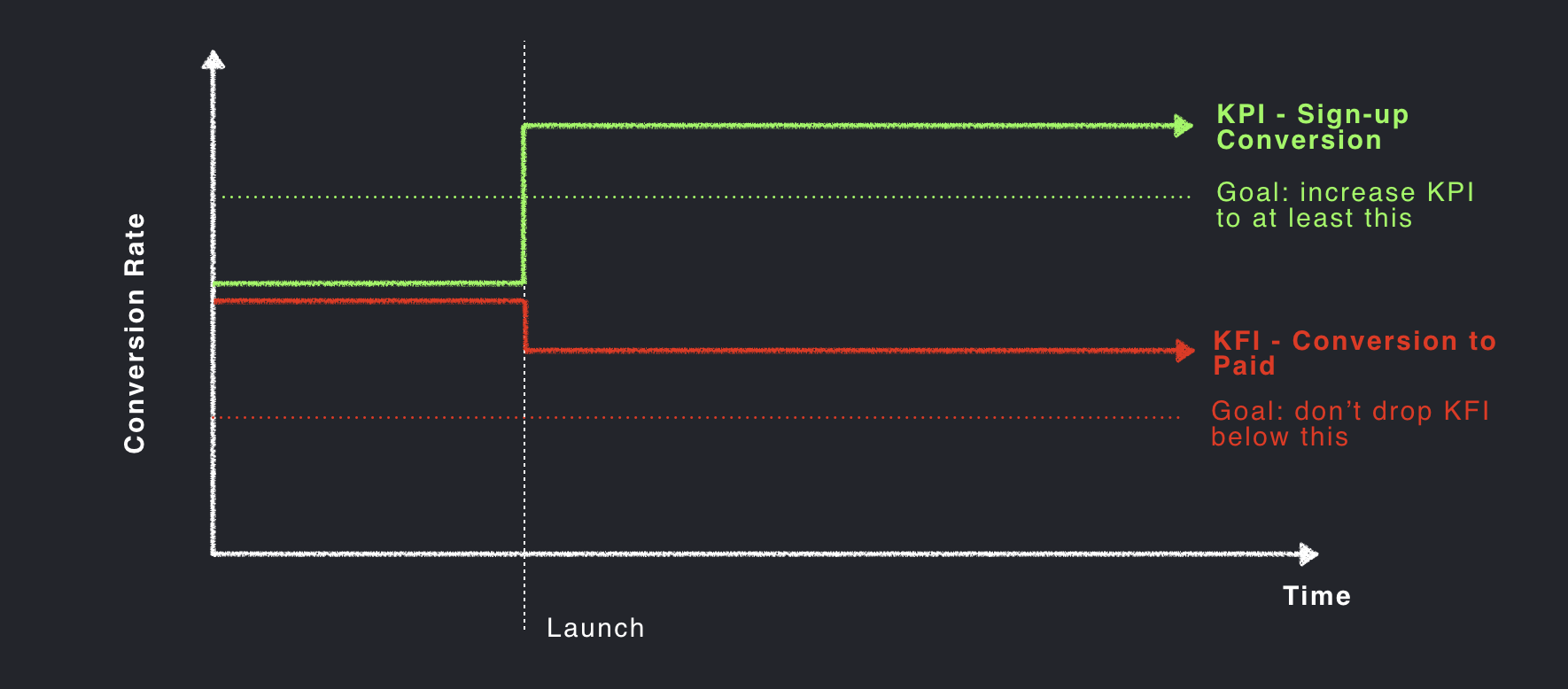
Why is it useful
Teams often choose a KPI that directly reflects the positive results they seek, without taking into account the negative ways to achieve these results. Once they start optimizing KPIs, they actually create a result that is bad for the company.
A classic example is a team that thinks it’s succeeded by doubling the conversion when registering on the landing page, but the total number of customers is not growing, because the conversion rate decreased by 60% due to this change.
KFI oversees the work of your team and ensures that you create only positive results for the company.
Examples of popular KPI <> KFI pairs:
- Revenue growth while maintaining gross margin
- Extend the use of feature A without refusing to accept feature B
- Expand the use of feature A without increasing the load on support
Case of life
(Nastya Utkina - Ozon Premium, Apparel & Beauty Product BX)
We know that the frequency of purchases (Frequency) of users with an Ozon Premium subscription is higher than that of users without a subscription (2-3 times)
It is also extremely important for the subscription economy that orders of frequency not lower than a certain AOV are frequency, otherwise they cost us significantly more than they bring.
These two indicators Frequency and AOV focus all our experiments on up-sell for premium users.
Network, not checklist
This may upset the reader, but there is no methodology for using mental models. If you try to use them as a checklist - looking at each one and checking if they are applicable - you will end up doing mental gymnastics, which will confuse and disappoint you and others.
Instead, models will help you make the right decisions about a product by providing a language to explain the reason for an action or choice.
With the accumulation of different models and the experience of their use, the result of the team will be better.
All Articles